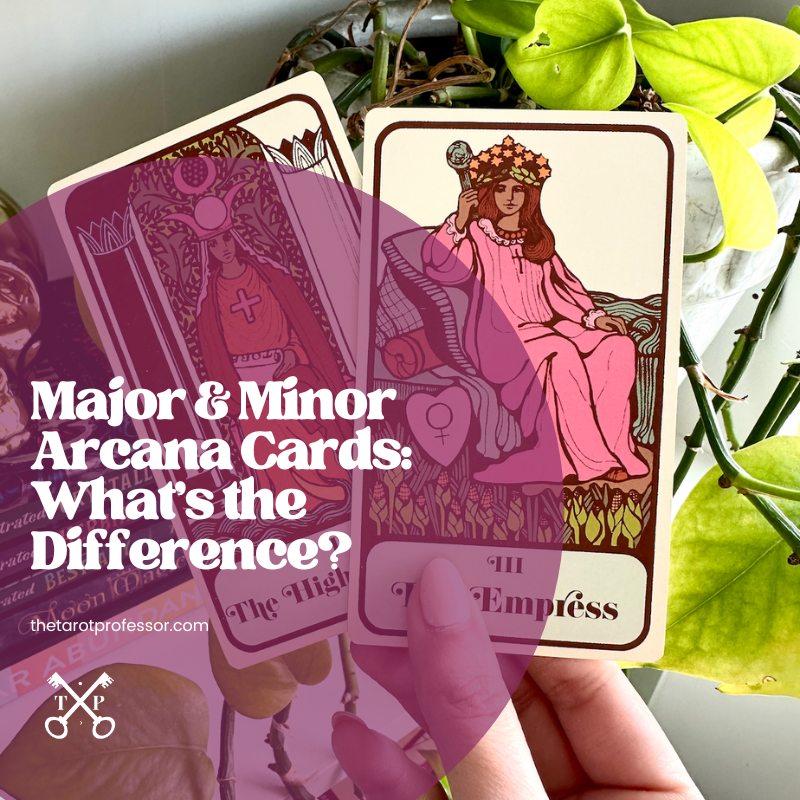
[I am a proud affiliate of Bookshop.org and this post may contain affiliate links to some of my favorite products. This means that I may earn a small commission at no extra cost to you if you follow one of my links and make a Bookshop.org purchase.]
What’s the difference between the Major and Minor Arcana cards in tarot? If you’re new to tarot, you may be wondering about this as you get familiar with your deck and tarot terminology.
In this post, you’ll learn more about the difference between the Major and Minor Arcana tarot cards to deepen and enrich your tarot readings.
How do tarot cards work exactly?
Tarot cards are a tool of self-discovery. They act as a mirror to your subconscious and a way to access your inner wisdom so you can live a life that is more aligned with your true and authentic self. So, working with tarot is a great way to practice using your intuition, feelings, and inner “knowing” to make decisions rather than relying solely on intellect and ego.
How exactly does tarot mirror our subconscious? Tarot cards depict imagery that reflects what is known as the collective unconscious – archetypes and symbols that we are all familiar with whether we consciously realize it or not. We learn these archetypes – stock characters or personality types – in various ways. These include human psychology, mythology, literature, culture, life experience, and even through our unconscious, inherited knowledge.
In fact, that’s why tarot works so well as a guidance system! It’s not just a bunch of random imagery. There is a system to it. And the first part of understanding that system is understanding the Major and Minor Arcana.
Which cards are the Major Arcana and which are the Minor?
The tarot deck is made up of 78 cards, which are organized in a very methodical way based on various concepts and systems. These include numerology, astrology, and more. For this post though, we will focus on the difference between the Major Arcana tarot cards and the Minor Arcana cards.
The first 22 cards of the tarot deck make up the Major Arcana. The remaining 56 cards comprise the Minor Arcana.
Let’s look at each Arcana in more detail.
The Major Arcana
Each deck of tarot cards includes 22 Major Arcana cards. The Major Arcana cards represent the major themes and lessons of life, which range from Strength and Temperance to Death and Judgement.
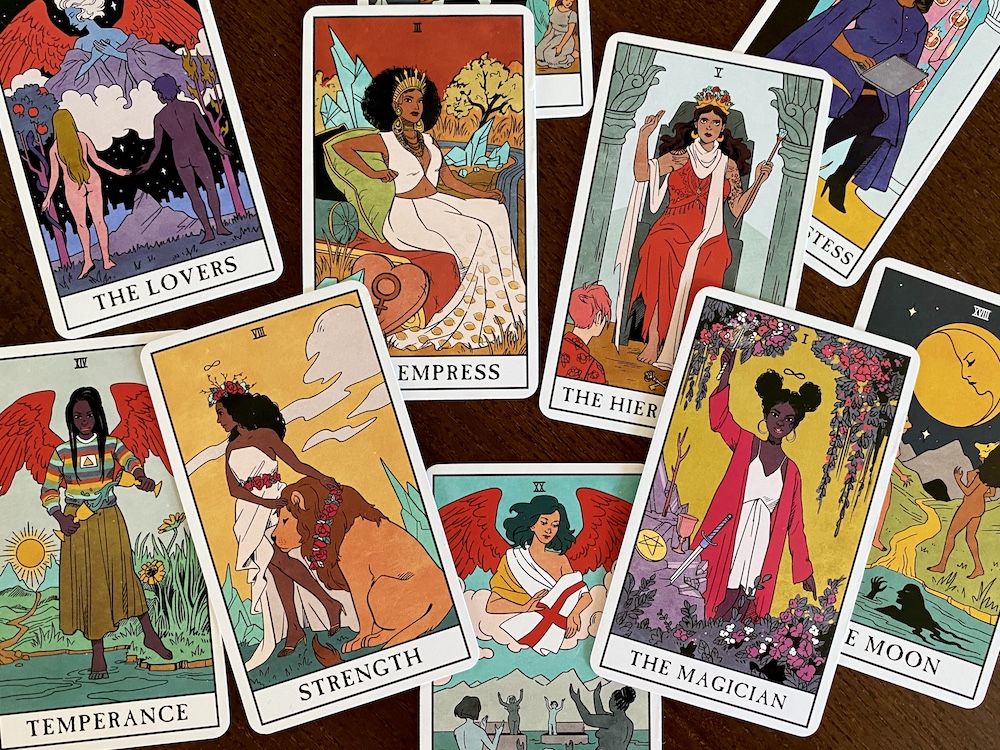
(Like this deck? It’s the Modern-Witch Tarot Deck, which you can purchase here. For more tips on finding a great tarot deck for beginners, check out this post.)
When a Major Arcana card shows up in a tarot reading, it indicates that an important, overarching energy is present, as opposed to a more minor or mundane circumstance of life. A tarot reading that is full of Major Arcana cards means an important lesson or shift is happening. It means potentially life-changing energy is present.
Major Arcana Life Lessons
Here is a list of the Major Arcana cards, in order, with their basic (but not only) meanings and themes.
0. The Fool – Leap of faith; trust in the universe
1. The Magician – Manifesting and taking action
2. The High Priestess – Intuitive wisdom; the subconscious
3. The Empress – Flow and creativity; the Divine Feminine
4. The Emperor – Structure and discipline; the Divine Masculine
5. The Hierophant – Esoteric knowledge; spiritual leadership; tradition
6. The Lovers – Duality; authentic connection; balance
7. The Chariot – Will power; journeys and transitions
8. Strength – Courage, strength, and grace under fire
9. The Hermit – Solitude; introspection and soul-searching
10. Wheel of Fortune – Cycles; the ups and downs of life
11. Justice – Fairness; forgiveness; facing consequences
12. The Hanged Man – Delays; need to shift perspective
13. Death – Transformation; loss; new beginnings
14. Temperance – Moderation; alchemy and healing
15. The Devil – Toxic patterns, unhealthy habits
16. The Tower – Major shifts; chaos; rebuilding from scratch
17. The Star – Authentic self-expression; faith
18. The Moon – Shadow self; fear; instincts
19. The Sun – Childlike innocence; positivity
20. Judgement – Belonging; spiritual awakening, soul’s purpose
21. The World – Success and completion; self-love
The Minor Arcana
If the Major Arcana deal with overarching themes and lessons of life, the Minor Arcana work with the more short-term or momentary circumstances of life. Things like deception, collaboration, introspection, rest, or gratitude.
While each Major Arcana card is unique, the 56 Minor Arcana cards are part of a repeating system. Like a regular deck of playing cards, the Minor Arcana are made up of 4 suits: Wands, Cups, Swords, and Pentacles.
Understanding the element associated with each suit helps interpret these cards.
Wands represent fire energy, which means passion, inspiration, and taking aligned action.
Cups represent water energy, which rules our emotions and intuition.
Swords represent air energy, which is all about mental processes and communication.
Finally, Pentacles represent earth energy, which means tangible areas of life like health and wealth.
In addition, each suit contains 14 cards: ten cards in numeric order from the Ace (one) to Ten, followed by the Page, Knight, Queen, and King of each suit.
Understanding basic numerology also helps make the Minor Arcana cards easier to interpret. (You can learn all about this in my online tarot course, Read Tarot Today, by the way!) For instance, in numerology, the number five represents instability or conflict. The fives in all four suits reflect this, as you can see below.
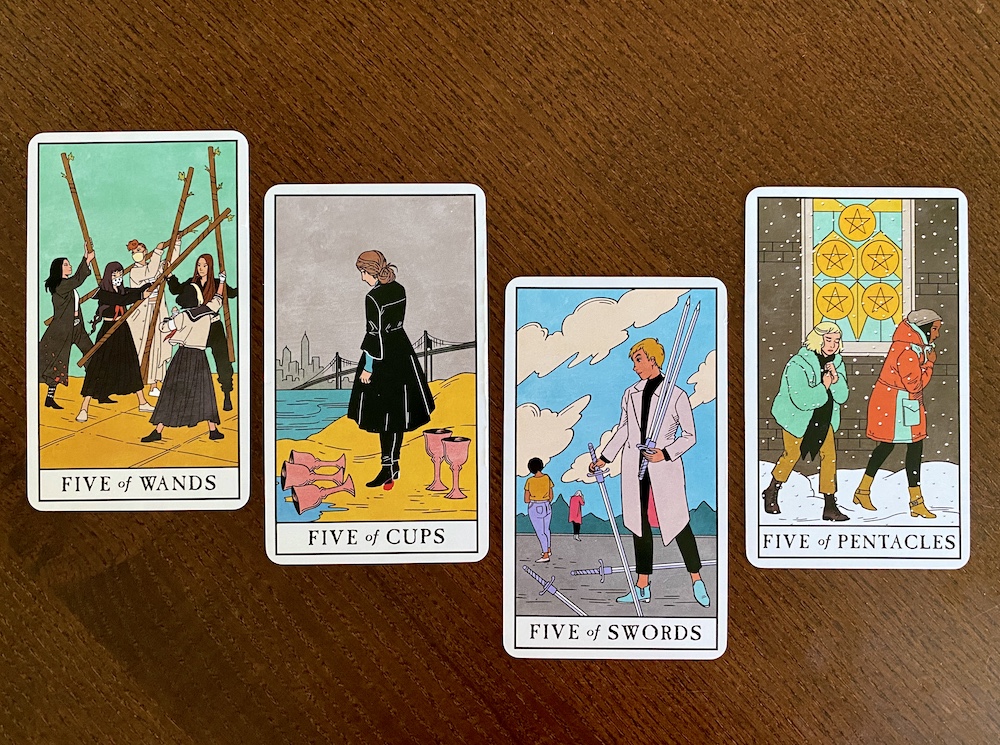
Want another example? Let’s look at the number nine. Being just one away from ten, which is completion or resolution, nine represents the home stretch or endurance in numerology. Below are the nines in all four suits of the Modern Witch Tarot Deck.
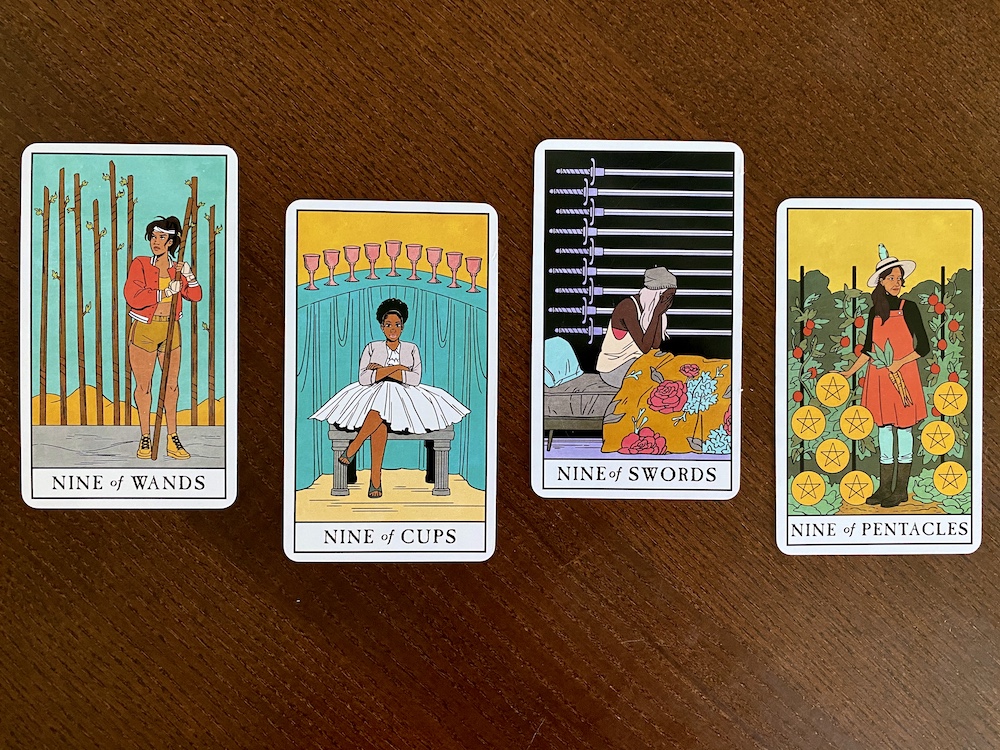
Here’s a four-card tarot spread to try.
The following Four-Card Check-In is the very first tarot spread I ever tried. It’s a great starter spread because it’s simple yet comprehensive. But more importantly for our purposes here, it helps you see the difference between the Major and Minor Arcana in the tarot.
Separate the Major and Minor Arcana cards in your deck.
For this spread, you need to separate your Major and Minor Arcana cards.
First, draw one Major Arcana card as your significator card. The significator card (sometimes called a signifier card) represents a major theme in your life right now, or a life lesson you are in the middle of learning. Since the Major Arcana deal with these lofty, overarching energies ( as we just learned), it makes sense to draw the significator card from the Major Arcana only.
Then, draw three Minor Arcana cards, each to represent one of the three realms of your life: the physical, mental, and spiritual. Like I said above, the Minor Arcana deal with more day-to-day energies and issues. That’s why to check in on your physical, mental, and spiritual realms for the day or the week, it makes sense to pull from the Minor Arcana cards.
What the spread looks like
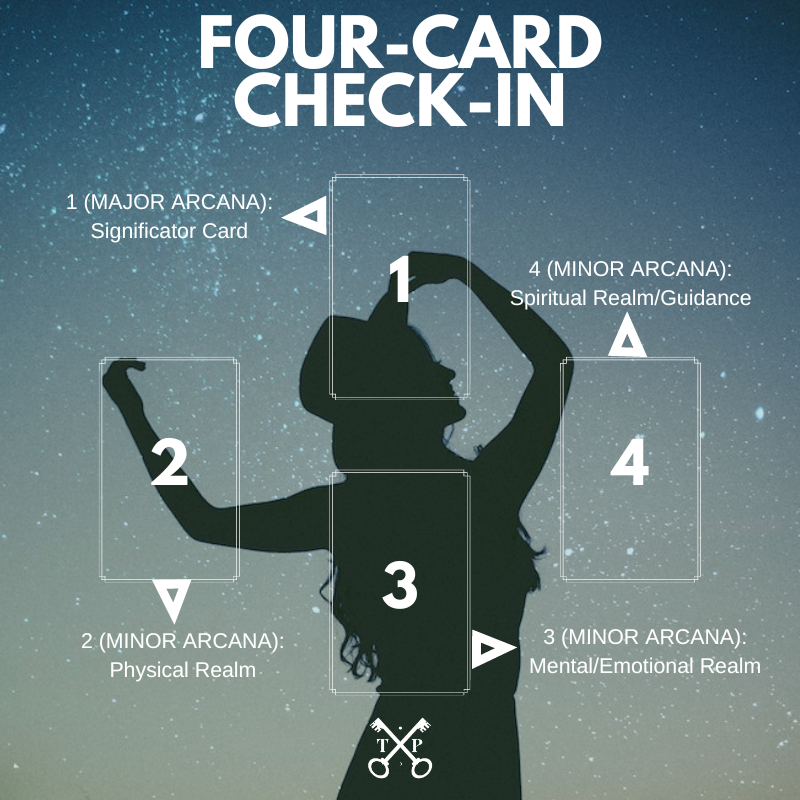
The signifier card (Card 1) drawn from the Major Arcana, tells you who you are in this moment. What’s weighing on your mind, what head and heart space you’re in, or a major theme in your life currently.
As for the other cards, drawn from the Minor Arcana:
- 2 tells you what you need to know about your physical realm right now;
- 3 tells you what you need to know about your mental or emotional realm right now; and
- 4 tells you what you need to know about your spiritual realm right now. This card could also be a message or special guidance from the Spirit or Universe.
Of course, in general, you don’t have to separate your Major and Minor Arcana cards. But it’s interesting and fun to try it every now and then!
(Click here for some easy three-card tarot spreads to try.)
Let me know if you try this spread or if you have any other questions about the Major or Minor Arcana in the comments below!



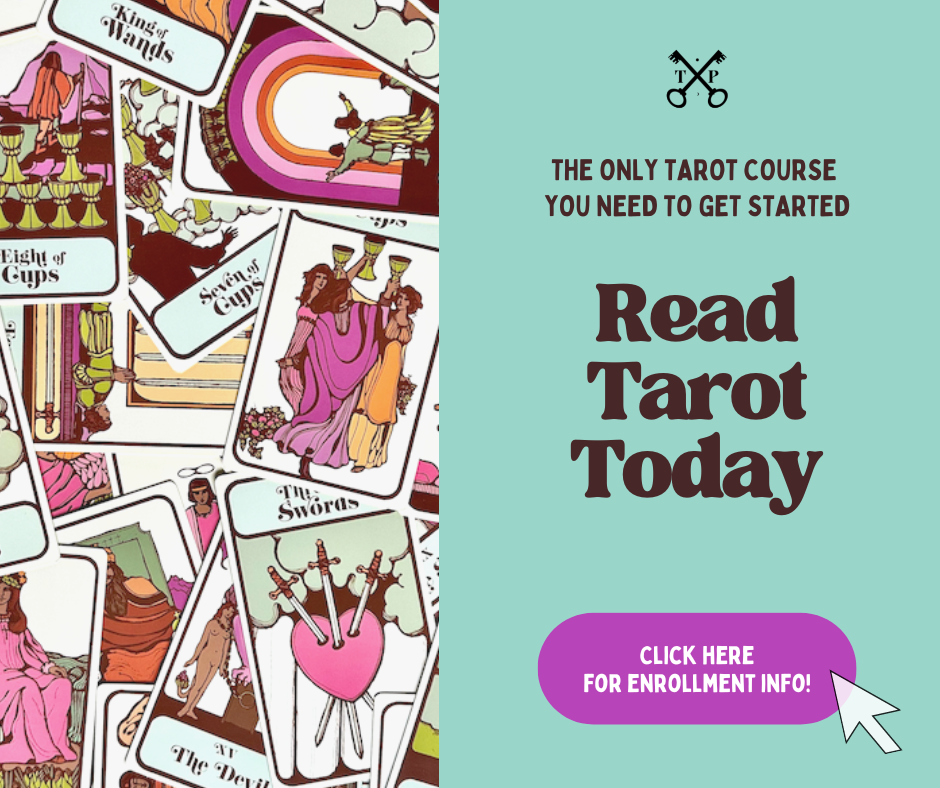
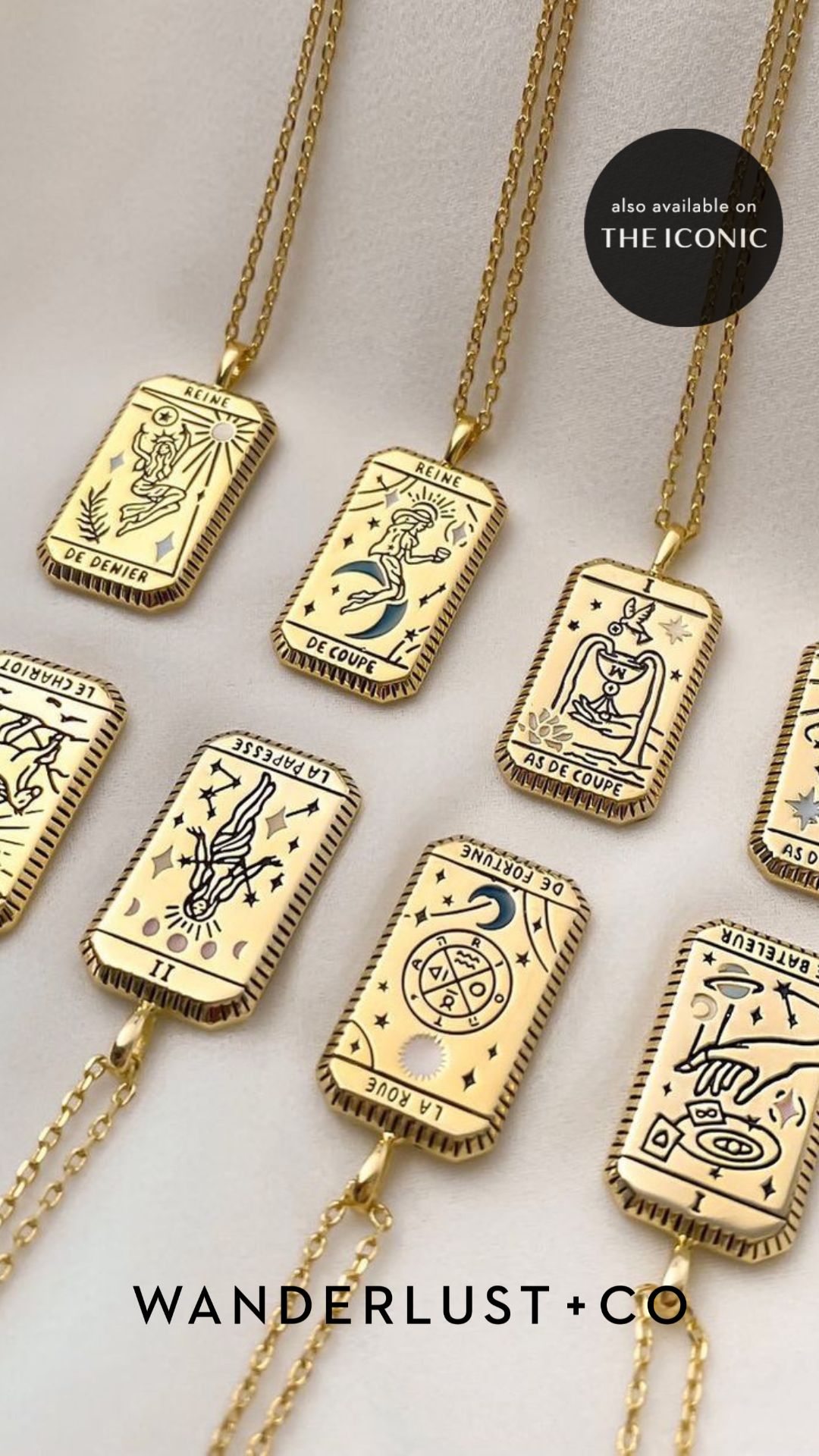
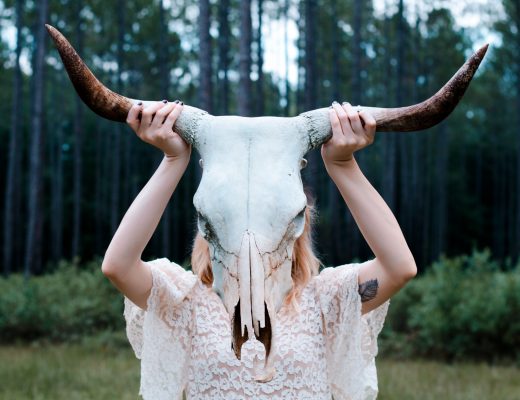
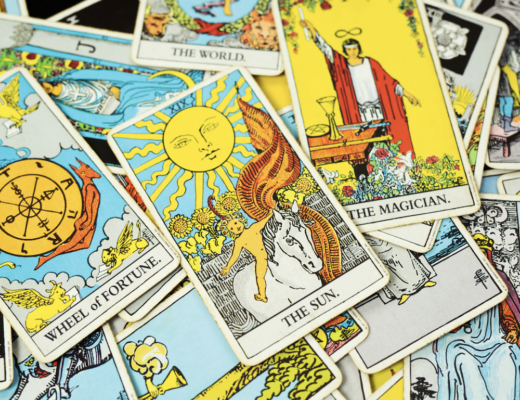
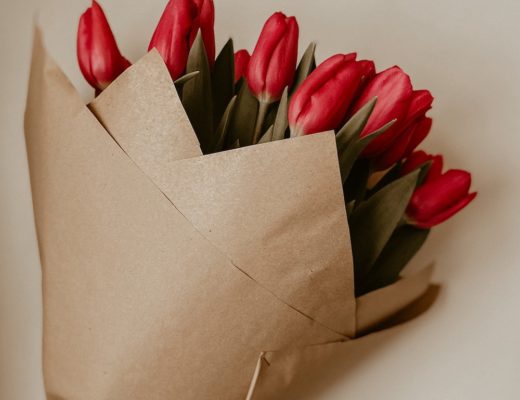
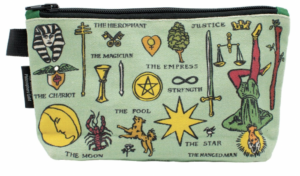
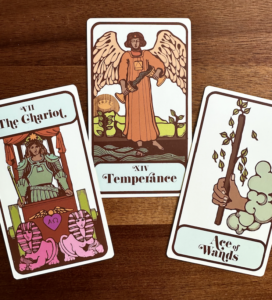
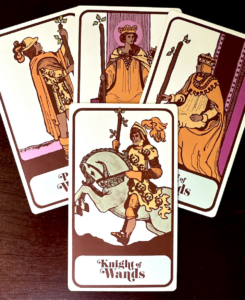
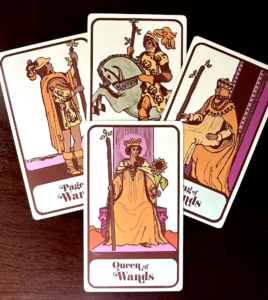
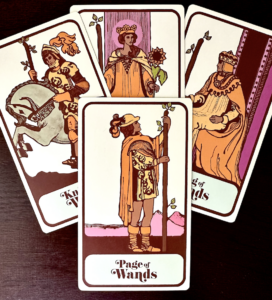
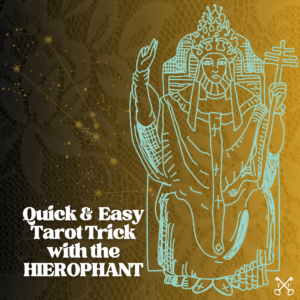

10 Comments
[…] (Click here for more on the difference between Major and Minor Arcana cards in tarot.) […]
[…] (Related: The Difference Between Major and Minor Arcana Cards in Tarot) […]
[…] is designed to mirror the human experience, the universal myth of man’s journey on earth. It reflects the major themes and life lessons we all have to learn at some point or another (authenticity, balance, catastrophe, change). Tarot also covers the […]
[…] use the name tarot way too freely in my opinion), has a set structure of 78 cards divided into the Major and Minor Arcana. More specifically, a standard tarot deck will have 22 Major Arcana cards and 56 Minor Arcana […]
[…] [Related: The Difference Between the Major and Minor Arcana] […]
[…] Tarot deck includes seventy-eight playing cards divided into two predominant classes: the Major Arcana and the Minor Arcana. The Major Arcana consists of 22 playing cards, every representing an extensive existence lesson or […]
[…] tarot deck grew richer with the addition of the Major and Minor Arcana. Occultism and mysticism shaped their meanings over time… adding depth to each card’s […]
[…] deck, it consists of 78 cards. Tarot Cards decks are typically divided into two major groups – Major and Minor Arcana. Major Arcana cards consist of 22 cards, while Minor Arcana consists of 56 cards. You might have […]
[…] Arcana features 22 cards that represent life’s most important themes and spiritual lessons [1]. These cards point to crucial energies in your life – the kind that lead to life-changing […]
[…] Tarot Basics: The Difference Between Major and Minor Arcana on http://www.thetarotprofessor.com […]